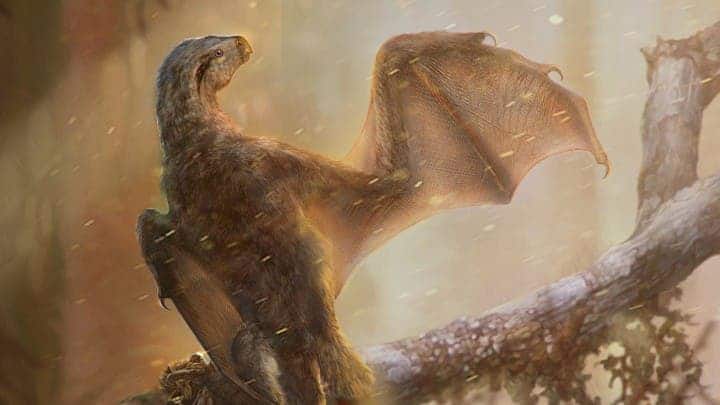If you were to take a walk through China 160 million years ago, you might have chanced upon an extremely unusual predator: a small dinosaur, gliding from tree to tree on its bat-like membrane wings. Ambopterix is only the second such dinosaur ever discovered.

Two years ago, a farmer from Wubaiding Village discovered a beautifully preserved fossil — so well-preserved, that he didn’t need any experience to understand that he’d come across something special. The farmer reached out to Min Wang from the Chinese Academy of Sciences, to come and have a look at the fossil. Wang knew that the only fossils ever discovered in that area were a pair of salamanders, so he didn’t get his hopes up. He took the trip nonetheless, and it was well worth it.
Right away, Wang knew something was special about this fossil. It was excellently preserved, but other things also stood out. Its sparrow-sized body featured a short tail and quill-like feathers. It was a dinosaur for sure, but a weird one at that. The real surprise, however, came when he looked at the left arm, noticing a thin bone coming down from the wrist, going down all the way to its arm — but not jointed like a finger. It was a wing.
“I shouted, and my heartbeat elevated,” he says.
“The most exciting thing, for me, is that it shows that some dinosaurs evolved very different structures to become volant,” (capable of some form of flight), says lead study author Min Wang,
It wasn’t the first such dinosaur ever discovered. In 2015, Yi qi (name thusly after the Mandarin for “strange wing”) sent ripples throughout the paleontological world, becoming the first known dinosaur that sported a membranous wing.
The fact that such dinosaurs existed isn’t exactly surprising. Evolution is rarely a linear process, and contrary to popular belief, it doesn’t find the best biological solution — it only finds one that works, and it often does so through a trial-and-error process. This goes to show that evolutionarily, dinosaurs were experimenting with a number of different wing types. Ambopterix, for instance, was more like a flying squirrel than a bird, gliding around the forest.
Its wings couldn’t have supported flapping flight. Unlike birds, fliers with leathery membranes (most notably bats and pterosaurs) have strong muscles to control the wings and prevent them from being pushed around by air currents. This dinosaur, however, had no such muscles.
Both Yi qi and Ambopterix are a part of a dinosaur group called scansoriopterygids, a rather obscure group of small dinosaurs, belonging to the same larger group as velociraptors and birds. It’s hard to know exactly what it looked like since its fossilized arms are folded (so we don’t really know how large they were fully outstretched).
It’s yet another stunning fossil found in China, the absolute El Dorado of modern paleontology.
The study has been published in Nature.






